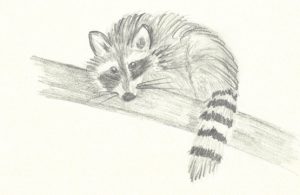 I got up early one morning last week to work. As I sat at the kitchen counter, I glanced outside and saw a raccoon scampering up a tree just a foot away from the house. By the time I grabbed my phone and opened the door, he had jumped to the roof. Seemingly unafraid, he did not move but just stared at me for long moments. I finally got cold and closed the door.
I got up early one morning last week to work. As I sat at the kitchen counter, I glanced outside and saw a raccoon scampering up a tree just a foot away from the house. By the time I grabbed my phone and opened the door, he had jumped to the roof. Seemingly unafraid, he did not move but just stared at me for long moments. I finally got cold and closed the door.
I know, it’s just a raccoon, common as church mice. And raccoons can be pests, getting into garbage and carrying nasty diseases such as rabies, but even so, I was thrilled to have this little wild creature right outside my door.
 Raccoons are easy to identify because of their masked faces and ringed tails. They weigh 8 – 18 pounds and measure 2 – 3 feet, including the tail. Raccoons have adapted well to living near humans and large populations can be found in cities and towns. They need to live near water and are abundant along wooded streams.
Raccoons are easy to identify because of their masked faces and ringed tails. They weigh 8 – 18 pounds and measure 2 – 3 feet, including the tail. Raccoons have adapted well to living near humans and large populations can be found in cities and towns. They need to live near water and are abundant along wooded streams.
Anyone who has watched the scene from the movie Elf, when Buddy tries to hug a raccoon, knows that raccoons can be downright vicious looking when provoked. Take it from Buddy, don’t try to hug a raccoon.
Raccoons have an amazing sense of touch. They are famous for “dousing” or acting like they are washing their food. Scientists say that the raccoon is not really trying to clean the food. Depending on which scientist you listen to, raccoons putting their paws in water over and over again is either a means of intensifying the sensory organs in their “hands” or is simply a nervous habit, as a raccoon is constantly using its paws and apparently, it’s hard to keep them still.
 The Sioux Indians called the raccoon “one who is sacred” or “one with magic,” probably because of its dark mask. The Dakota Sioux called it wee-kah-teg-alega, “sacred one with the painted face.”
The Sioux Indians called the raccoon “one who is sacred” or “one with magic,” probably because of its dark mask. The Dakota Sioux called it wee-kah-teg-alega, “sacred one with the painted face.”
I don’t know how sacred he was, but I am happy that this little masked fellow brought a bit of magic to my morning.

Do raccoons put their paws in water over and over again if they are not holding food? Is holding food the only circumstance in which they intensify their sensory perception, or do they hold other things in water also to increase their “feel” for them? Many questions about the magical raccoon!
I’m always interested to see undomesticated animals about in the world — raccoons, possums, deer — if they’re not eating my plants — even squirrels.